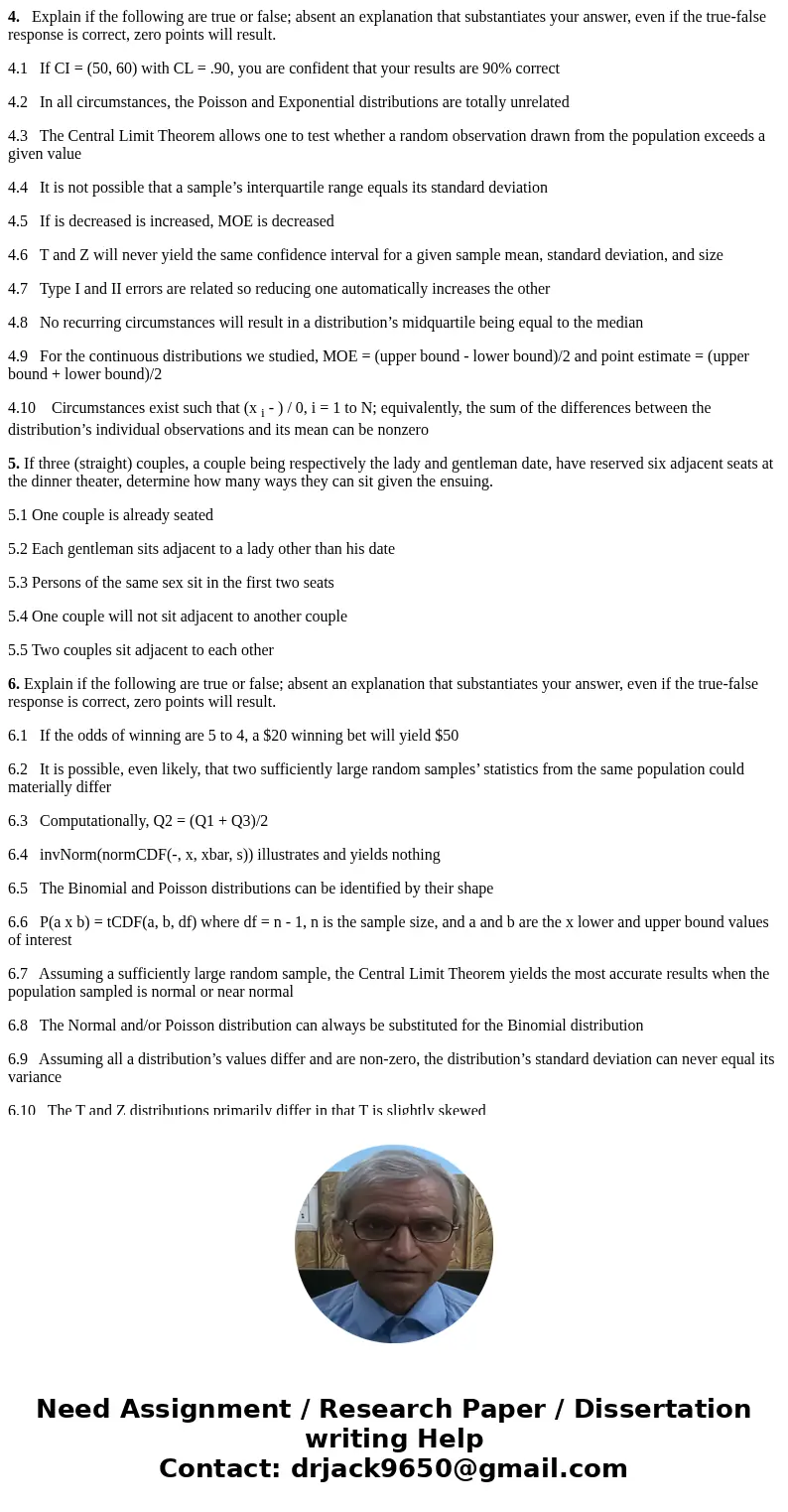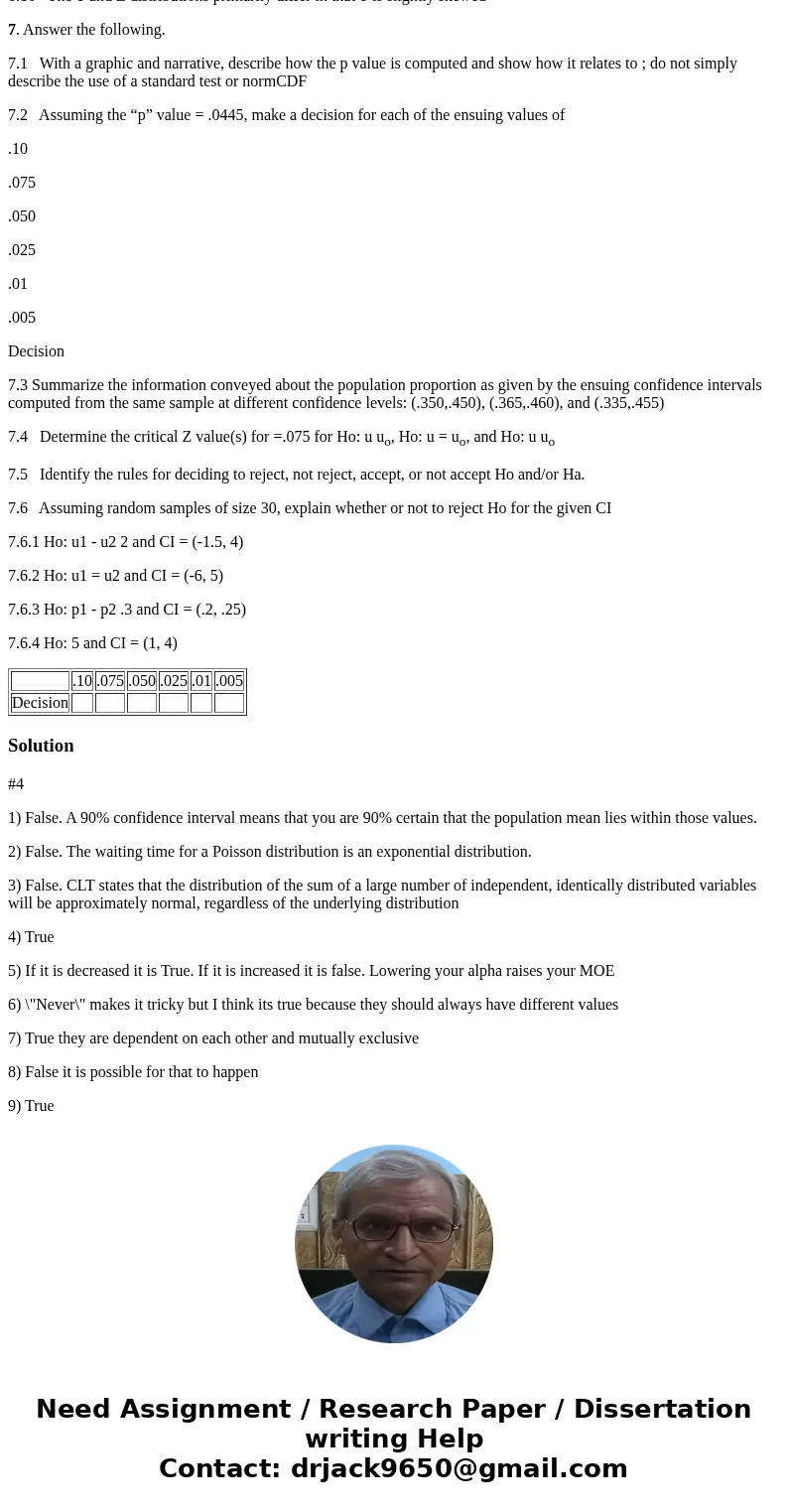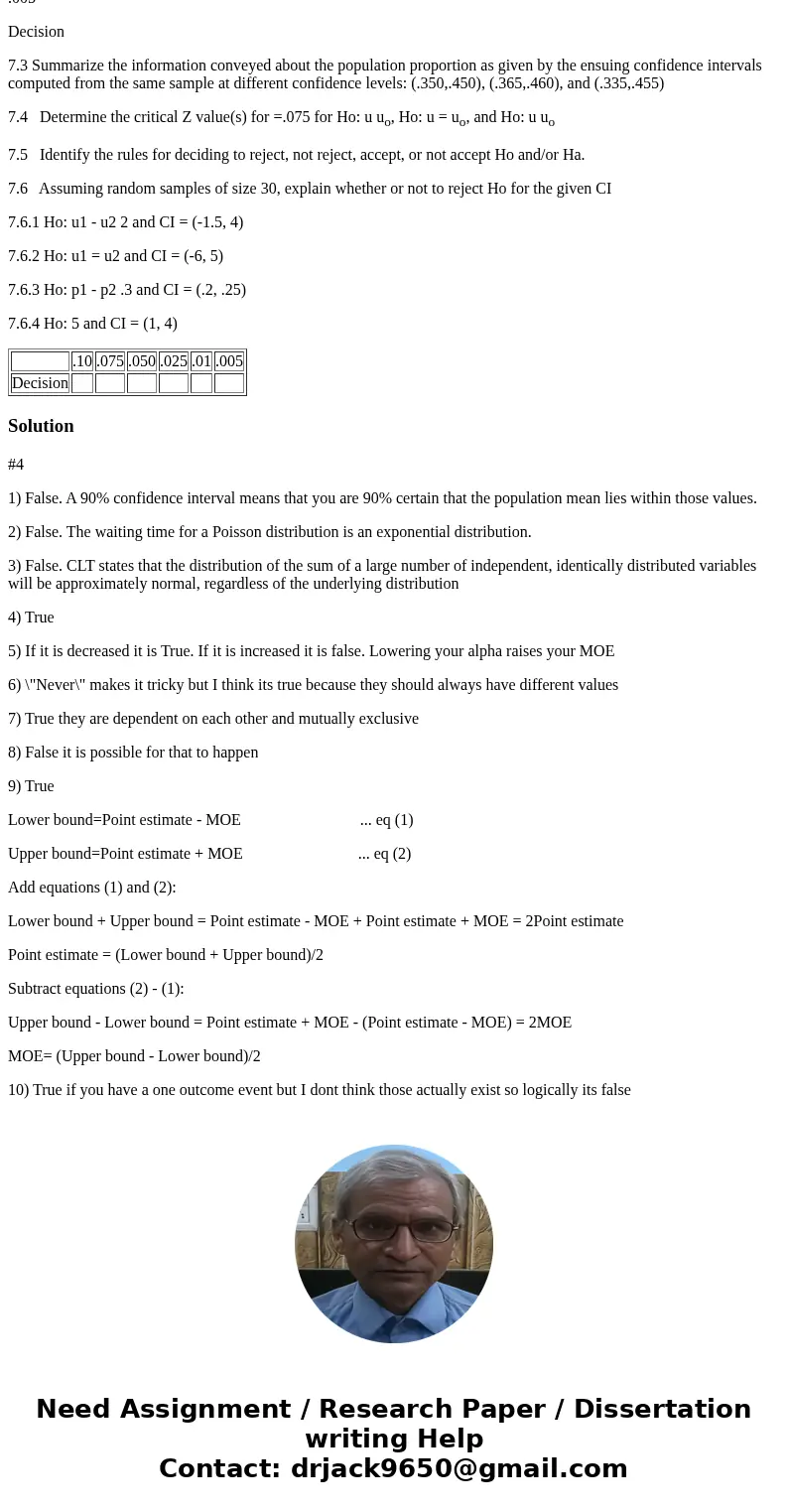4 Explain if the following are true or false absent an expla
4. Explain if the following are true or false; absent an explanation that substantiates your answer, even if the true-false response is correct, zero points will result.
4.1 If CI = (50, 60) with CL = .90, you are confident that your results are 90% correct
4.2 In all circumstances, the Poisson and Exponential distributions are totally unrelated
4.3 The Central Limit Theorem allows one to test whether a random observation drawn from the population exceeds a given value
4.4 It is not possible that a sample’s interquartile range equals its standard deviation
4.5 If is decreased is increased, MOE is decreased
4.6 T and Z will never yield the same confidence interval for a given sample mean, standard deviation, and size
4.7 Type I and II errors are related so reducing one automatically increases the other
4.8 No recurring circumstances will result in a distribution’s midquartile being equal to the median
4.9 For the continuous distributions we studied, MOE = (upper bound - lower bound)/2 and point estimate = (upper bound + lower bound)/2
4.10 Circumstances exist such that (x i - ) / 0, i = 1 to N; equivalently, the sum of the differences between the distribution’s individual observations and its mean can be nonzero
5. If three (straight) couples, a couple being respectively the lady and gentleman date, have reserved six adjacent seats at the dinner theater, determine how many ways they can sit given the ensuing.
5.1 One couple is already seated
5.2 Each gentleman sits adjacent to a lady other than his date
5.3 Persons of the same sex sit in the first two seats
5.4 One couple will not sit adjacent to another couple
5.5 Two couples sit adjacent to each other
6. Explain if the following are true or false; absent an explanation that substantiates your answer, even if the true-false response is correct, zero points will result.
6.1 If the odds of winning are 5 to 4, a $20 winning bet will yield $50
6.2 It is possible, even likely, that two sufficiently large random samples’ statistics from the same population could materially differ
6.3 Computationally, Q2 = (Q1 + Q3)/2
6.4 invNorm(normCDF(-, x, xbar, s)) illustrates and yields nothing
6.5 The Binomial and Poisson distributions can be identified by their shape
6.6 P(a x b) = tCDF(a, b, df) where df = n - 1, n is the sample size, and a and b are the x lower and upper bound values of interest
6.7 Assuming a sufficiently large random sample, the Central Limit Theorem yields the most accurate results when the population sampled is normal or near normal
6.8 The Normal and/or Poisson distribution can always be substituted for the Binomial distribution
6.9 Assuming all a distribution’s values differ and are non-zero, the distribution’s standard deviation can never equal its variance
6.10 The T and Z distributions primarily differ in that T is slightly skewed
7. Answer the following.
7.1 With a graphic and narrative, describe how the p value is computed and show how it relates to ; do not simply describe the use of a standard test or normCDF
7.2 Assuming the “p” value = .0445, make a decision for each of the ensuing values of
.10
.075
.050
.025
.01
.005
Decision
7.3 Summarize the information conveyed about the population proportion as given by the ensuing confidence intervals computed from the same sample at different confidence levels: (.350,.450), (.365,.460), and (.335,.455)
7.4 Determine the critical Z value(s) for =.075 for Ho: u uo, Ho: u = uo, and Ho: u uo
7.5 Identify the rules for deciding to reject, not reject, accept, or not accept Ho and/or Ha.
7.6 Assuming random samples of size 30, explain whether or not to reject Ho for the given CI
7.6.1 Ho: u1 - u2 2 and CI = (-1.5, 4)
7.6.2 Ho: u1 = u2 and CI = (-6, 5)
7.6.3 Ho: p1 - p2 .3 and CI = (.2, .25)
7.6.4 Ho: 5 and CI = (1, 4)
| .10 | .075 | .050 | .025 | .01 | .005 | |
| Decision |
Solution
#4
1) False. A 90% confidence interval means that you are 90% certain that the population mean lies within those values.
2) False. The waiting time for a Poisson distribution is an exponential distribution.
3) False. CLT states that the distribution of the sum of a large number of independent, identically distributed variables will be approximately normal, regardless of the underlying distribution
4) True
5) If it is decreased it is True. If it is increased it is false. Lowering your alpha raises your MOE
6) \"Never\" makes it tricky but I think its true because they should always have different values
7) True they are dependent on each other and mutually exclusive
8) False it is possible for that to happen
9) True
Lower bound=Point estimate - MOE ... eq (1)
Upper bound=Point estimate + MOE ... eq (2)
Add equations (1) and (2):
Lower bound + Upper bound = Point estimate - MOE + Point estimate + MOE = 2Point estimate
Point estimate = (Lower bound + Upper bound)/2
Subtract equations (2) - (1):
Upper bound - Lower bound = Point estimate + MOE - (Point estimate - MOE) = 2MOE
MOE= (Upper bound - Lower bound)/2
10) True if you have a one outcome event but I dont think those actually exist so logically its false



 Homework Sourse
Homework Sourse